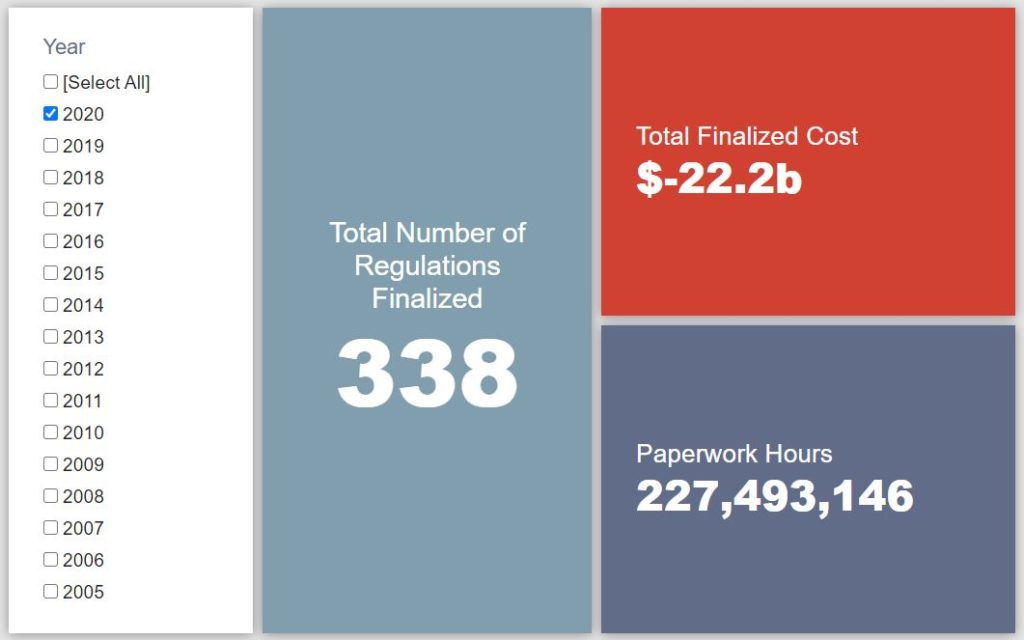Week in Regulation
November 2, 2020
Net-Cost Week Led by Another “Off-Budget” Rule
Last week saw a return to a sizable net-cost total, due primarily to a single rule. That single rule – with stated costs in the billions of dollars – provides a curious example of how regulatory budget accounting can hinge upon nuanced categorizations. Meanwhile, all other regulations with some measurable economic impact combined to yield roughly $21.6 million in net costs. Across all rulemakings, agencies published $4.5 billion in total net costs and added 3.6 million hours of annual paperwork.
REGULATORY TOPLINES
- Proposed Rules: 39
- Final Rules: 55
- 2020 Total Pages: 69,033
- 2020 Final Rule Costs: -$22.2 billion
- 2020 Proposed Rule Costs: $15.9 billion
TRACKING THE REGULATORY BUDGET
The most consequential rule of the week was actually explicitly deemed exempt from regulatory budget consideration for fiscal year (FY) 2021 due to it primarily focusing on transfer payments. The Department of Agriculture (USDA) rule regarding “Environmental Quality Incentives Program (EQIP)” finalizes changes to EQIP made by the 2018 Farm Bill. USDA estimates that these amended requirements would impose roughly $860 million in annual costs, or $4.5 billion in present value. How one defines these “costs,” however, gets somewhat complicated.
Per USDA, the program in question “incentivizes agricultural producers to conserve and enhance soil, water, air, plants, animals (including wildlife), energy, and related natural resources on their land” via sizable transfers to said producers. These incentive payments are, of course, conditional upon meeting myriad requirements, and as such USDA has included them as costs in its analysis. Nevertheless, the agency and the Office of Information and Regulatory Affairs consider it exempt from the regulatory budget tally. This is likely due to its emphasis on transfers and that the program itself is voluntary. These factors are notable, but these stated costs require recognition – even if it is outside the official regulatory budget – given: 1) that these payments (the motivating factor in participating) are inherently contingent upon meeting regulatory requirements, and 2) the significant scale of costs involved in passing muster under the program.
While the administration’s FY 2021 regulatory budget caps are still forthcoming, so far this fiscal year agencies have officially published 18 deregulatory actions and 5 regulatory actions, totaling $2 billion in quantified total net costs. The American Action Forum’s review of the administration’s FY 2020 regulatory budget progress can be found here.
THIS WEEK’S REGULATORY PICTURE
This week, the Department of Energy (Energy) creates a pathway for faster dishwashers.
On October 30, Energy published a new rule that will allow for faster dishwashers in the Federal Register. Prior to the new rule, there were only two classes of dishwashers allowable under Energy’s regulations, standard and compact. Under regulations finalized in 2013, newly manufactured standard dishwashers cannot exceed 307 kilowatt hours per year (kwh/year) and five gallons per cycle. This results in “normal” cycles of washing and drying of more than two hours.
The new rule creates a third class of dishwashers; standard dishwashers with a normal cycle of less than 60 minutes. While most current standard dishwasher have “quick” cycles, that cycle is only intended for lightly soiled dishes.
The new rule is a result of a petition for rulemaking filed by the Competitive Enterprise Institute (CEI) in May 2018. CEI argued that as a result of the 2013 rule, consumers had become dissatisfied with how long it took their dishwashers to complete a cycle. Its petition cited an Energy technical document that acknowledged that “[t]o help compensate for the negative impact on cleaning performance associated with decreasing water use and water temperature, manufacturers will typically increase the cycle time.”
After accepting the petition, Energy conducted testing that showed “a dishwasher with a ‘normal’ cycle time of 60 minutes or less is achievable, and that establishing a product class where the ‘normal’ cycle is 60 minutes or less could spur manufacturer innovation to generate additional product offerings to fill the market gap that exists for these products.”
The new rule only enables manufacturers to pursue faster standard dishwashers. Subsequent rulemaking will be needed to set exact technical specifications that the new class of dishwashers must meet.
TOTAL BURDENS
Since January 1, the federal government has published $6.3 billion in total net cost savings (with $22.2 billion from finalized rules) and 283 million hours of net annual paperwork burden increases (with 227.5 million hours due to final rules). Click here for the latest Reg Rodeo findings.













